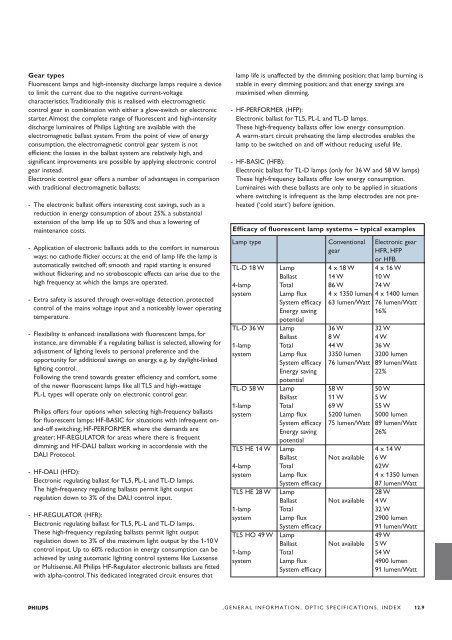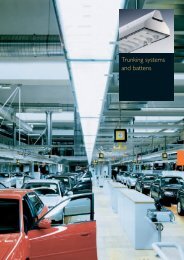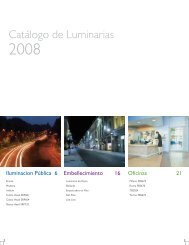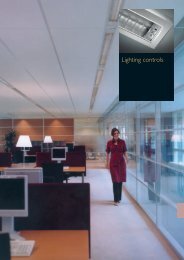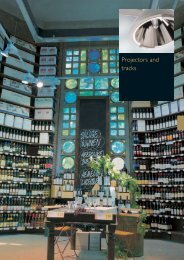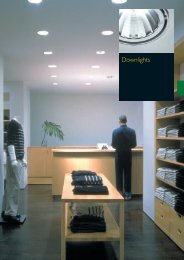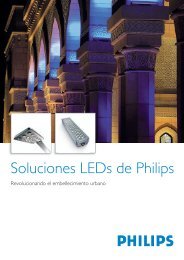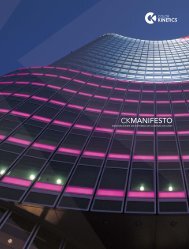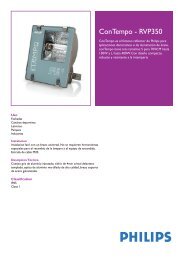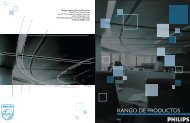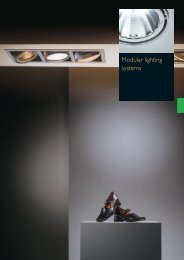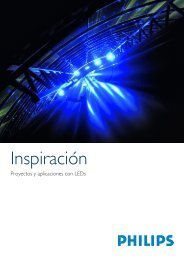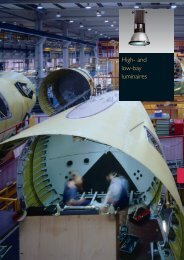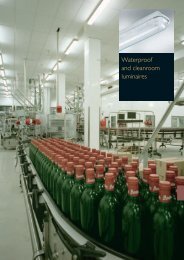General information, optic specifications, index
General information, optic specifications, index
General information, optic specifications, index
You also want an ePaper? Increase the reach of your titles
YUMPU automatically turns print PDFs into web optimized ePapers that Google loves.
L946D947_SRC.QXD 11-03-2004 08:15 Pagina 12.9<br />
Gear types<br />
Fluorescent lamps and high-intensity discharge lamps require a device<br />
to limit the current due to the negative current-voltage<br />
characteristics.Traditionally this is realised with electromagnetic<br />
control gear in combination with either a glow-switch or electronic<br />
starter.Almost the complete range of fluorescent and high-intensity<br />
discharge luminaires of Philips Lighting are available with the<br />
electromagnetic ballast system. From the point of view of energy<br />
consumption, the electromagnetic control gear system is not<br />
efficient: the losses in the ballast system are relatively high, and<br />
significant improvements are possible by applying electronic control<br />
gear instead.<br />
Electronic control gear offers a number of advantages in comparison<br />
with traditional electromagnetic ballasts:<br />
- The electronic ballast offers interesting cost savings, such as a<br />
reduction in energy consumption of about 25%, a substantial<br />
extension of the lamp life up to 50% and thus a lowering of<br />
maintenance costs.<br />
- Application of electronic ballasts adds to the comfort in numerous<br />
ways: no cathode flicker occurs; at the end of lamp life the lamp is<br />
automatically switched off; smooth and rapid starting is ensured<br />
without flickering; and no stroboscopic effects can arise due to the<br />
high frequency at which the lamps are operated.<br />
- Extra safety is assured through over-voltage detection, protected<br />
control of the mains voltage input and a noticeably lower operating<br />
temperature.<br />
- Flexibility is enhanced: installations with fluorescent lamps, for<br />
instance, are dimmable if a regulating ballast is selected, allowing for<br />
adjustment of lighting levels to personal preference and the<br />
opportunity for additional savings on energy, e.g. by daylight-linked<br />
lighting control.<br />
Following the trend towards greater efficiency and comfort, some<br />
of the newer fluorescent lamps like all TL5 and high-wattage<br />
PL-L types will operate only on electronic control gear.<br />
Philips offers four options when selecting high-frequency ballasts<br />
for fluorescent lamps: HF-BASIC for situations with infrequent onand-off<br />
switching; HF-PERFORMER where the demands are<br />
greater; HF-REGULATOR for areas where there is frequent<br />
dimming; and HF-DALI ballast working in accordensie with the<br />
DALI Protocol.<br />
- HF-DALI (HFD):<br />
Electronic regulating ballast for TL5, PL-L and TL-D lamps.<br />
The high-frequency regulating ballasts permit light output<br />
regulation down to 3% of the DALI control input.<br />
- HF-REGULATOR (HFR):<br />
Electronic regulating ballast for TL5, PL-L and TL-D lamps.<br />
These high-frequency regulating ballasts permit light output<br />
regulation down to 3% of the maximum light output by the 1-10 V<br />
control input. Up to 60% reduction in energy consumption can be<br />
achieved by using automatic lighting control systems like Luxsense<br />
or Multisense.All Philips HF-Regulator electronic ballasts are fitted<br />
with alpha-control.This dedicated integrated circuit ensures that<br />
lamp life is unaffected by the dimming position; that lamp burning is<br />
stable in every dimming position; and that energy savings are<br />
maximised when dimming.<br />
- HF-PERFORMER (HFP):<br />
Electronic ballast for TL5, PL-L and TL-D lamps.<br />
These high-frequency ballasts offer low energy consumption.<br />
A warm-start circuit preheating the lamp electrodes enables the<br />
lamp to be switched on and off without reducing useful life.<br />
- HF-BASIC (HFB):<br />
Electronic ballast for TL-D lamps (only for 36 W and 58 W lamps)<br />
These high-frequency ballasts offer low energy consumption.<br />
Luminaires with these ballasts are only to be applied in situations<br />
where switching is infrequent as the lamp electrodes are not preheated<br />
(‘cold start’) before ignition.<br />
Efficacy of fluorescent lamp systems – typical examples<br />
Lamp type Conventional Electronic gear<br />
gear HFR, HFP<br />
or HFB<br />
TL-D 18 W Lamp 4 x 18 W 4 x 16 W<br />
Ballast 14 W 10 W<br />
4-lamp Total 86 W 74 W<br />
system Lamp flux 4 x 1350 lumen 4 x 1400 lumen<br />
System efficacy 63 lumen/Watt 76 lumen/Watt<br />
Energy saving 16%<br />
potential<br />
TL-D 36 W Lamp 36 W 32 W<br />
Ballast 8 W 4 W<br />
1-lamp Total 44 W 36 W<br />
system Lamp flux 3350 lumen 3200 lumen<br />
System efficacy 76 lumen/Watt 89 lumen/Watt<br />
Energy saving 22%<br />
potential<br />
TL-D 58 W Lamp 58 W 50 W<br />
Ballast 11 W 5 W<br />
1-lamp Total 69 W 55 W<br />
system Lamp flux 5200 lumen 5000 lumen<br />
System efficacy 75 lumen/Watt 89 lumen/Watt<br />
Energy saving 26%<br />
potential<br />
TL5 HE 14 W Lamp 4 x 14 W<br />
Ballast Not available 6 W<br />
4-lamp Total 62W<br />
system Lamp flux 4 x 1350 lumen<br />
System efficacy 87 lumen/Watt<br />
TL5 HE 28 W Lamp 28 W<br />
Ballast Not available 4 W<br />
1-lamp Total 32 W<br />
system Lamp flux 2900 lumen<br />
System efficacy 91 lumen/Watt<br />
TL5 HO 49 W Lamp 49 W<br />
Ballast Not available 5 W<br />
1-lamp Total 54 W<br />
system Lamp flux 4900 lumen<br />
System efficacy 91 lumen/Watt<br />
,GENERAL INFORMATION, OPTIC SPECIFICATIONS, INDEX 12.9


